The Sechelt First Nation is prepared to form a blockade to keep coal ships from passing through its territory, according to Chief Calvin Craigan.
His statement came after a flurry of arsenic-laden coal washed ashore on a Texada Island beach, near Lafarge Canada Inc.’s Texada Quarry coal storage facility, following a recent permit amendment approved by the Ministry of Energy and Mines (MEM) without consultation.
“Be assured, we will take a stand,” Craigan told the Peak. “We will blockade and put a stop to this. We’ve always protected our resources and they have sustained us for all these years. We are not going to stop now.”
In a press release issued by Kevin Washbrook, director of Voters Taking Action on Climate Change, he stated the province quietly issued the permit amendment over a month ago and had not announced it publicly.
The coal handling facility on Texada currently handles up to 400,000 tonnes of coal each year from Quinsam Mine on Vancouver Island, but the permit amendment means that it could handle up to eight million tonnes of U.S. thermal coal each year as well. The U.S. coal would be delivered by barge from Fraser Surrey Docks, if the Vancouver Fraser Port Authority (also known as Port Metro Vancouver) approves that company’s proposal to build a coal terminal there. A decision by the port is expected in June.
Local residents and landowners visited the coal handling facility several times during the summer of 2013 and each time documented coal on the beach. They say it is coal that is presumably being lost into the water during handling. The Lafarge permit explicitly prohibits release of coal into the water or foreshore at the coal handling facility.
Washbrook’s release added that both MEM and Ministry of Environment (MOE) were notified twice in 2013 of the discovery of coal on the beach. A MEM technician was sent to the site to investigate on February 17, 2014, and reported that no coal contamination was present in the area. However, at their own expense, residents and landowners geo-referenced, photographed and collected samples for testing by an independent laboratory.
André Sobolewski is an impact assessment and water treatment specialist with Clear Coast Consulting. He received the results of the independent flurry analysis and was asked to interpret the results as well as to offer some suggestions on what could be done next.
“When they came to me they wanted to be sure, with absolute certainty, that the results were what they appeared to be,” Sobolewski said. “The Ministry of Environment had already sent their own people to look at the material. They said it was not coal. In the results I received, it was tested for a variety of possibilities —wood debris and the like. When I saw that the composition compared with coal from a variety of other places — coal from Maryland, for example — and saw the arsenic content, it was conclusive.”
Sobolewski said the sample results contained the highest levels of arsenic he had seen in 25 years of testing. He recommended that MOE look seriously at the results.
In an email to the Peak, MEM spokesperson Matt Gordon said the Ministry has conducted studies to determine the level of arsenic in the coal destined to be stored on Texada.
“There have been studies completed on the levels of arsenic regarding Texada,” he said.
In response to a question about danger from leachate into surrounding environment and water, he added, “The environment and water are covered under a water management plan and monitoring and significant safety measures will be put in place as part of the permit.”
As far as consultation with First Nations is concerned, Gordon said the Mines Act permits decisions by the chief inspector of mines, or delegate, and that these are statutory decisions, “completely independent of any political influence.”
He said the Ministry sent out the application “to referral agencies, First Nations, and posted advertisements to the public,” and added that the application was made available to the public. He said process has been followed, which included a public meeting that took place on Aug. 19, 2013. “Confirmations have been sent in the mail to interested parties.”
Washbrook’s news release also stated that an email was sent April 10 by BC Environmental Assessment Office to a concerned citizen. The email revealed that MEM had in fact approved up to a 20-fold expansion in coal exports from Texada Island one month earlier.
Sechelt First Nation, Sunshine Coast Regional District the Islands Trust, and Nicholas Simons, MLA for Powell River-Sunshine Coast, were all notified of the permit approval by B.C. residents.
“There has definitely been a deliberate attempt to sidestep public consultation here,” Craigan said. “We asked the Ministry of Energy and Mines for clarification on when they planned to consult with us. We got no response.”



